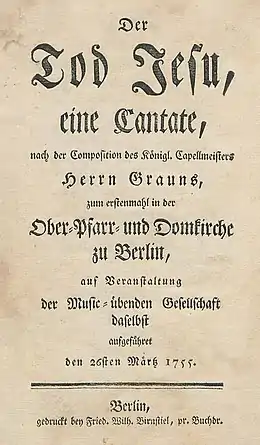
Der Tod Jesu (The Death of Jesus) is an oratorio libretto by Karl Wilhelm Ramler. In its setting by Carl Heinrich Graun in 1755, it was the most often performed Passion of the 18th century in Germany.
The poem is part of the Empfindsamkeit movement of the 1750s. It is the middle of three oratorio texts by Ramler – Die Hirten bei der Krippe zu Bethlehem, Der Tod Jesu, and Die Auferstehung und Himmelfahrt – which may have been viewed by Ramler as a libretto cycle, though they were never set as a cycle by any composer.[1] The libretto was intended for Graun but a copy of Ramler's text was somehow received by Telemann who produced his own setting of the oratorio (TWV 5:6) in Hamburg before Graun could perform the premiere in Berlin. Ramler revised his text in 1760.
The text is not a full retelling of the Passion of Christ and it does not quote Bible texts. Instead, it presents emotively various aspects of the Passion.
Settings
- Georg Philipp Telemann, Hamburg 1755, TWV 5:6
- Carl Heinrich Graun, Berlin 1755 – the best known of the settings; it was performed yearly in many cities in Germany throughout the second half of the 18th century. The Australian premiere of Graun's passion cantata took place on Good Friday 2012 in St John's Cathedral in Brisbane with the Badinerie Players and the Brisbane Chamber Choir under Michael O'Loghlin and with Shelli Hulcombe (soprano), Bethany Shepherd (soprano), Gregory Massingham (tenor), Jason Barry-Smith (bass).[2]
- Adolf Friedrich Hesse (1809–1863) composed an Organ Introduction, Op. 84, to Graun's work.
- Johann Christoph Friedrich Bach, cantata (1769) BR D 2 / Wf XIV:1, based on Ramler's revised version from 1760
- Joseph Martin Kraus to his own libretto (1776), in the Sturm und Drang style
- Anna Amalia, Abbess of Quedlinburg, used by Johann Kirnberger as models of counterpoint in his Die Kunst des reinen Satzes in der Musik (The art of pure musical composition) (1779)[3]
- Christian Ernst Graf (1723–1804, The Hague 1802
Compositional style
Unlike Bach's Passions, Graun's setting does not imbue the tenor soloist with the role of narrator or Evangelist, nor is the bass cast as Vox Christi. The music is post-Baroque, an italianate galant style, and contains little counterpoint (notably in the duet, no. 17) or fugal movements (chorus no. 14 is a double fugue). Instead, it gives prominence to melody and voice. All arias are da capo arias with stylistic borrowings from opera arias. Grauner's recitative settings are highly expressive, culminating in the moving simplicity of the bass's recitative no. 23 on the death of Jesus, "Er ist nicht mehr!" (He is no more!). The last chorus starts quite powerfully, but then ebbs away into a mystical silence.
Movements
Graun's settings consists of 25 movements:
- Part 1
- Chorale – Du, dessen Augen flossen
- Chorus – Sein Odem ist schwach
- Accompanied recitative (soprano) – Gethsemane! Gethsemane!
- Aria (soprano) – Du Held, auf den die Köcher
- Chorale – Wen hab' ich sonst als Dich allein
- Recitative (soprano) – Ach mein Immanuel!
- Aria (soprano) – Ein Gebet um neue Stärke
- Recitative (tenor) – Nun klingen Waffen
- Aria (tenor) – Ihr weichgeschaffnen Seelen
- Chorus – Unsre Seele ist gebeuget
- Chorale – Ich will von meiner Missetat
- Recitative (bass) – Jerusalem, voll Mordlust
- Aria (bass) – So stehet ein Berg Gottes
- Chorus – Christus hat uns ein Vorbild gelassen
- Part 2
- Chorale – Ich werde Dir zu Ehren alles wagen
- Recitative (soprano) – Da stehet der traurige, verhängnisvolle Pfahl
- Duet (sopranos) – Feinde, die ihr mich betrübt
- Recitative (soprano) – Wer ist der Heilige, zum Muster uns verliehn
- Aria (soprano) – Singt dem göttlichen Propheten
- Chorus – Freuet euch alle ihr Frommen
- Chorale – Wie herrlich ist die neue Welt
- Recitative (bass) – Auf einmal fällt der aufgehaltne Schmerz
- Accompanied recitative (bass) – Es steigen Seraphim
- Chorale with bass solo – Ihr Augen, weint!
- Chorus – Hier liegen wir gerührte Sünder
A performance takes about 1+3⁄4 hours.
Selected recordings
- Telemann
- Ex Tempore, Le Mercure Galant. conductor Florian Heyerick. René Gailly
- Telemann Chamber Orchestra, conductor Ludger Rémy. cpo
- Graun
- Capella Savaria, conductor Pál Németh. HM Quintana
- La Petite Bande, conductor Sigiswald Kuijken. Hyperion Records 2003[4]
- Das Kleine Konzert, conductor Hermann Max, cpo 2009
- Kraus – with Kom! din herdestaf att bära, Philharmonia Chor Stuttgart, Stuttgarter Kammerorchester, Helmut Wolf. Carus-Verlag 1997
References
- ↑ Howard E. Smither A History of the Oratorio 2000 p. 88 "One might also view the three texts by Carl Wilhelm Ramler – Die Hirten bei der Krippe zu Bethlehem, Der Tod Jesu, and Die Auferstehung und Himmelfahrt – as a libretto cycle, but these seem never to have been set by a single composer."
- ↑ "Good Friday Musical devotion" Archived 2012-04-02 at the Wayback Machine, The Cathedral Chamber Choir perform Der Tod Jesu
- ↑ Briscoe, James R. (2004). New Historical Anthology of Music by Women. Vol. 1 (2nd ed.). Indiana University Press. p. 109. ISBN 9780253216830.
- ↑ Der Tod Jesu at Hyperion Recors, with extensive details
Further reading
External links
- Der Tod Jesu (Graun): Scores at the International Music Score Library Project